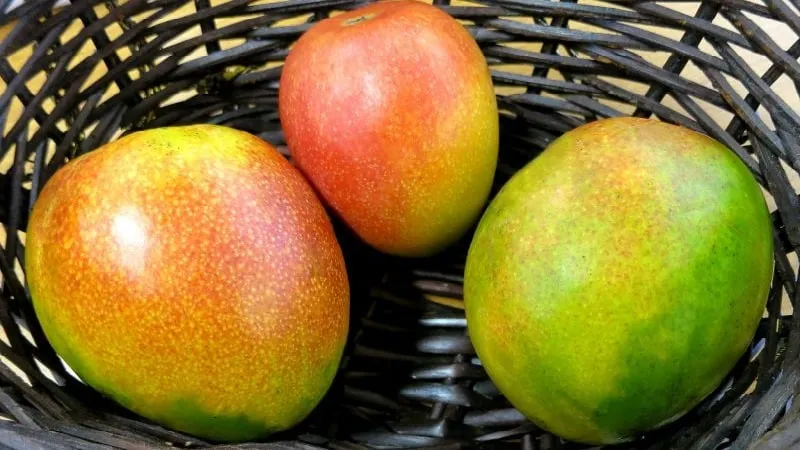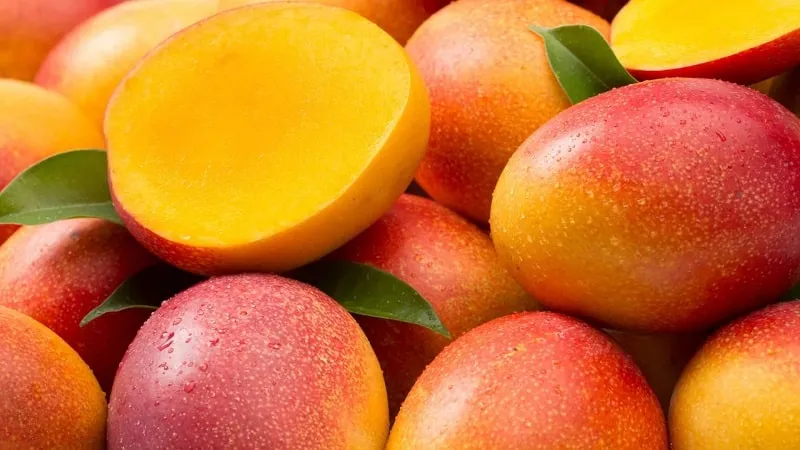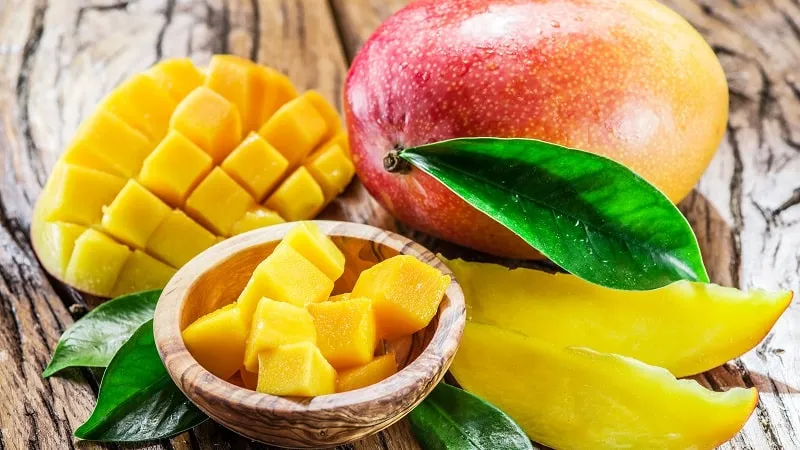Translated from Sanskrit – the ancient language of India – mango means "the great fruit". Its consumption volume surpasses that of bananas and apples worldwide. This tropical fruit has won the hearts of Europeans thanks to its rich, sweet taste and pleasant resinous-fruity aroma with floral notes. In this article, we will explain how to determine mango ripeness and ripen a green fruit at home.
Table of contents
Can You Eat Unripe Mango and How to Ripen It at Home
The most popular varieties – Thai, Philippine, Vietnamese, and Balinese mango. The skin colour ranges from yellow, green, orange to red. The shape can be elongated, round, egg-shaped, or pear-shaped. The average weight of one fruit is 300-400 g, with some specimens reaching up to 1 kg.
Mangoes arrive on the European market unripe. This is due to the nature of tropical fruits. The same applies to bananas and pineapples. A green, barely edible fruit can ripen off the tree naturally. It produces ethylene gas – the so-called "ripening hormone". Under its influence, tannins break down, and starch converts into sugar. The discovery of this process is credited to the German botanist Friedrich Haberlandt.

Picked mangoes can ripen faster than those left on the tree. Under conditions of water scarcity or accidental damage, ethylene production increases. Placing a ripe fruit next to unripe ones speeds up the ripening process.
Often, mangoes ripen during transit from the tropics to European shelves, so you might find perfectly ripe fruit in stores.
A red skin colour does not indicate full ripeness but rather that the fruit received ample sunlight while still on the tree.
How to tell if the fruit is still unripe: it feels heavy and firm to the touch, has dark green skin, lacks fragrance, the pit is hard to remove when cut, and the flesh tastes sour and astringent. Some describe the taste of unripe mango as soapy and unpleasant.
Can you eat unripe mango? In its homeland, India, unripe mangoes are used to prepare sauces, marinades, and side dishes for fish and meat. So instead of discarding a green mango, you can slice it into a salad or add it to a vegetable stew for a tangy twist.
Interesting fact! Alcohol and mango are completely incompatible. The acids in the flesh irritate the stomach lining and, when combined with alcohol, can cause nausea, vomiting, and digestive discomfort.
How to Ripen Mango at Home
Where should you place a mango to ripen? If you’ve bought an unripe fruit, leave it at room temperature on a tray next to bananas or apples. In 3-4 days, it will soften and become ready to eat.
Here are a few simple ways to speed up ripening using newspaper, baking paper, or grains.

Wrapping in Paper
If you’ve bought a green mango, how can you ripen it? Paper can help. Wrap the mango in newspaper or baking parchment and place it in a dark spot at room temperature. After 24-48 hours, it will soften, and a fruity aroma will develop.
Wrapping the mango with an apple or banana accelerates the process due to increased ethylene release.
Ripening with Grains
Indian households use a proven ripening method: placing the mango in a bowl, pot, or bag of uncooked rice. Under these conditions, the fruit ripens not in days but in just a few hours. For example, if you place the mango in rice in the morning, by evening – or at the latest, the next morning – it will be ripe. Experienced cooks recommend checking every 3-7 hours to avoid overripening.
How else can you ripen a mango? Besides rice, corn kernels or other grains work too. This method is commonly used in Mexican households.
Note. Unripe fruits contain more ascorbic acid, while ripe ones have more vitamin A and less vitamin C.
Determining Ripeness and Proper Storage
To avoid wondering how to ripen a mango later, it’s best to check its ripeness when buying. Here’s how:
- A ripe fruit emits a strong, sweet-resinous, fruity scent, especially near the stem.
- When pressed, the flesh yields slightly, like a ripe peach.
- The skin of a ripe mango is shiny, smooth, and firm, with colours ranging from yellow to red-orange, depending on the variety. Some green-skinned mangoes have orange flesh, but these are rare in European markets.
- Dark spots on the surface don’t always indicate spoilage – they may simply mean the fruit is high in sucrose. However, if the spots are soft and easily indented, avoid buying.
- The most flavourful and aromatic mangoes tend to be round-shaped.

A perfectly ripe mango smells like a mix of pineapple and peach with a hint of pine. Connoisseurs believe a strong fragrance is the best indicator of ripeness.
Storage guidelines:
- Never refrigerate unripe mangoes – this slows ripening and leads to spoilage. Ripe or overripe mangoes should be kept in the fridge’s fruit drawer.
- A ripe mango lasts 5-6 days in the fridge at +2…+5°C and up to six months in the freezer at –18°C. Freezing preserves flavour well.
- Cut mango spoils quickly, darkens, and loses taste. Store sliced fruit in an airtight container for no more than 24 hours.
- An unripe mango can last up to 7 weeks at +7…+9°C and 90% humidity.
Conclusion
If you’ve bought a green mango, how can you ripen it? Indian households use an effective method – ripening the fruit in uncooked rice. This boosts natural ethylene production, yielding a ripe mango in under 24 hours.
Wrapping in newspaper or parchment is another efficient way to ripen mangoes, though it takes up to 48 hours. If there’s no rush, simply leave the fruit at room temperature for a few days.







